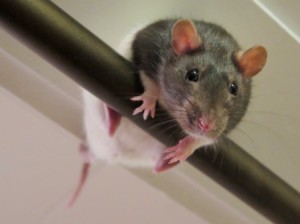 At the very end of 2013, I audited an online nose work class offered through Fenzi Dog Sports Academy, which was taught by Margaret Simek. It was a lot of fun and left me even more fascinated with the sport of canine nose work.
At the very end of 2013, I audited an online nose work class offered through Fenzi Dog Sports Academy, which was taught by Margaret Simek. It was a lot of fun and left me even more fascinated with the sport of canine nose work.
I worked through most of the exercises in the course with Amy the rat. We didn’t get too far with our nose work training, however, because Amy started to have some health problems. This spring, foster dog Henry and I also played around just a little bit with the nose work exercises.
I have wanted to do some more nose work training, as I find nose work both challenging and a lot of fun. So, I decided that nose work would be a great project for Flower the rat and me for this fall. Flower knows a few tricks, although I really haven’t done that much training with her.
The video below shows days 7 and 8 of Flower’s training. We have been doing 3-4 short sessions a day, each about one minute long. So, she’s had about half an hour of training time up to this point.
Watch on YouTube: Nose work training with Flower the rat
In the video, you’ll see four small Altoids tins. One contains a Q-tip that has been coated with sweet birch oil (winter green). The other three tins are empty. Flower’s task is to search among the tins, find the correct one and then (importantly) stop searching and remain at the correct tin. She remains there while I feed her several treats. Then, I mix up the tins and she has to search again.
At the beginning, I started by holding one tin and teaching her to keep her nose near it. I wanted her to learn first and foremost that this smell was the best smell in the world and was a great smell to find!
Then, I moved the tin around the training area so that she actually had to go to it and then stay there while I gave her treats. This was the very beginning of teaching her to search for the tin. Gradually, we added a second tin to the mix, then a third and a fourth.
If you watch closely, you can see that her body language changes when she finds the correct tin. This is probably clearest at 1:30 in the video — you’ll see her sniff past two empty tins and then find the correct tin. When she finds the correct tin, she starts sniffing more intensely and her body posture actually changes.
It’s pretty important at the beginning of nose work training to quickly get to the point where the animal is searching between two to three boxes or tins. If a trainer practices with just one box or tin, the animal might learn to find the box based on visual cues, rather than scent cues. If there are two or three identical boxes, the animal cannot rely on any visual cues and must find the correct box based on smell.
As we keep working on this, we’ll add more boxes and add in some distractions. Eventually, we’ll move on to searches where the hidden scent is not in a box and Flower actually has to search a certain area and find the scent. For example, a scent could be hidden between two books on a book shelf.
We’ll keep training and report back later on!
